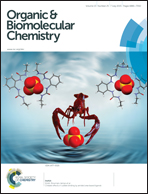Peptide 2-formylthiophenol esters do not proceed through a Ser/Thr ligation pathway, but participate in a peptide aminolysis to enable peptide condensation and cyclization†
Abstract
Peptide thiol salicylaldehyde (SAL) esters unexpectedly do not follow a Ser/Thr ligation pathway to react with peptides containing N-terminal Ser/Thr, but proceed towards a peptide aminolysis in DMSO. The reaction takes place even at a low substrate concentration (1 mM). The method has been successfully used to synthesize several natural cyclic peptides, with a high ratio of monocyclic to dimeric products.


 Please wait while we load your content...
Please wait while we load your content...